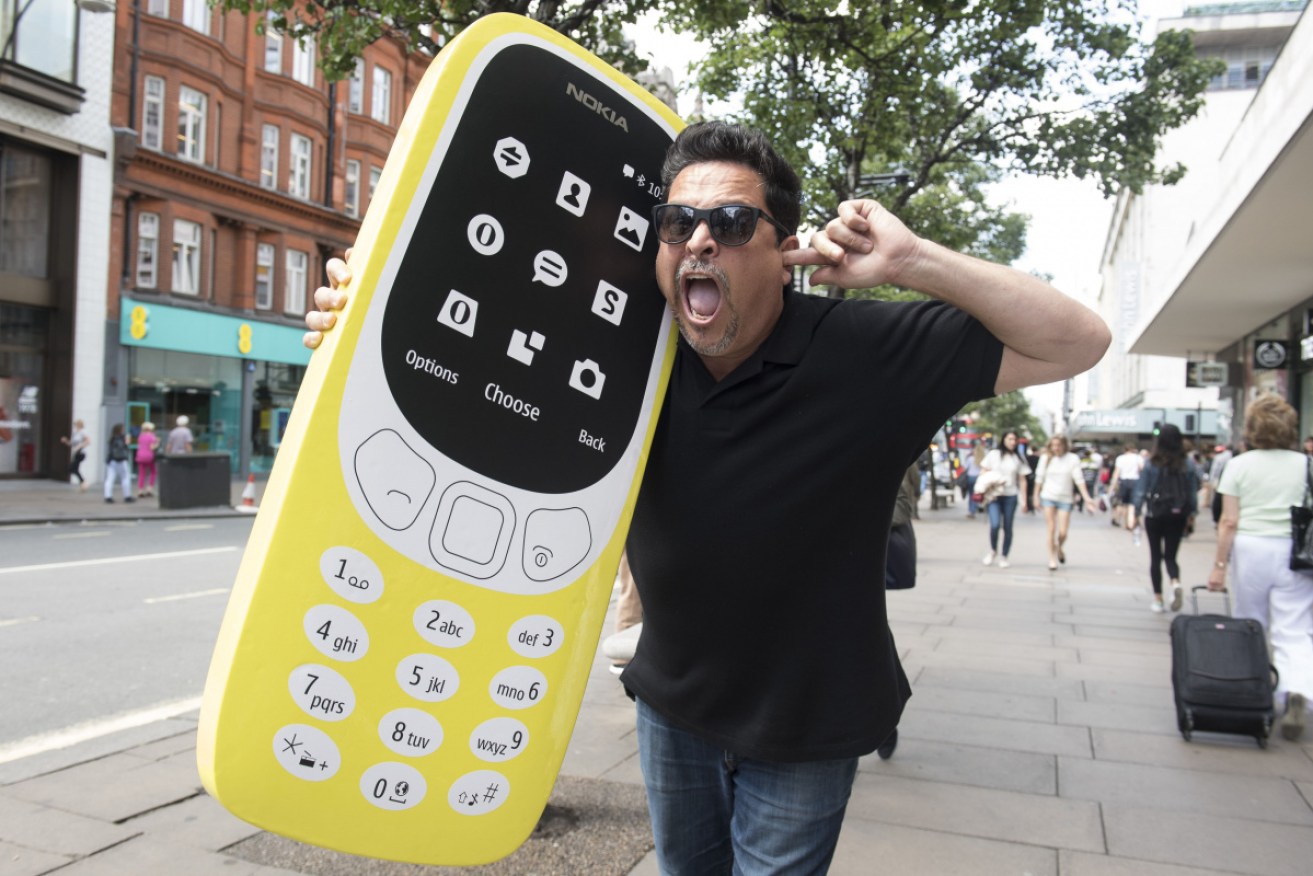Review: Nokia’s ‘Brick’ should be tied to a real one and thrown off a bridge


The Nokia 3310 always will be the best phone that ever rang. Nokia tried to create that magic with the 220. Photo: Getty
The year was 2000. Faith Hill’s Breathe was the hit song. We were safe from the Y2K bug. And Nokia released the classic 3310.
Never has such function been packaged in such an elegant form. And not just function – fun, too. Snake, anyone?
For many of us, the 3310 was our first introduction to a lifetime of having a mobile phone permanently attached to our persons. And we were spoiled. Remember not having to charge your phone every 45 minutes? Not having to wrap it in 17 layers of NASA-grade silicone to keep it crack-free? Remember not having to take out a personal loan just to buy the darn thing? (Yes, I’m looking at you, $2000 iPhone.)
They were good times.
Fast forward 20 years and Nokia has tried to bring a ray of sunshine back into the world with the Nokia 220 – RRP $89.
The little fella dropped onto my desk, for the purposes of reviewing. (My colleague got the new whizz-bang Google phone. Guess who the golden employee is?)
It’s billed as a back-to-basics phone – it makes calls, sends texts, has Snake. Heck, it even has a camera and lets you access some small corners of the internet.
“Enjoy more freedom with a long-lasting battery. Browse, download, call, play and listen without worrying where the nearest power outlet is,” Nokia touts.
Yes, yes I would love to enjoy more freedom, thank you 220. I was excited to break free from the shackles of my do-all-the-things smartphone, if only for a week.
Off on this wild adventure I embarked, with Faith Hill playing gently in the background.
Day one: Acclimatisation
The first thing I realise about using the 220 (affectionately referred to as The Brick) is that I’ll be without the magic of Spotify during my commute, otherwise afforded by my iPhone.
Thankfully, The Brick packs an SD card. “I can just load music onto the card, and away we go,” I think. Alas, I don’t have any music stored on my computer (because what 20-something-year-old does?), and no-one in my sharehouse has a card reader.
I search for my iPod for three hours in my 30-centimetre-squared bedroom. No dice.
That’s OK, I say, slightly panicked by now. The Brick has a built-in radio. I’ll listen to some PBS and ABC talkback and get educated. (Spoiler alert: the radio doesn’t work on the train. Something about being inside a high-speed metal canister doesn’t agree with its limited reception capabilities.)
I then realise 90 per cent of my conversations take place via Facebook Messenger and WhatsApp, save the old people in my life. (Hi, Mum.)
I have to send out alerts to my group chats to tell them to text me for the next week because I’m going off grid. I know they’re not going to text me, and accept a state of FOMO.
Next, it takes a housemate and me half a bottle of wine, two YouTube clips and 35 minutes to figure out how to put the SIM card in the darn thing. Then I remember it’s a Nokia, therefore practically indestructible. I promptly turn into the Hulk and wrench the back open.
We’re on.
Day two: This is fine
The 220’s alarm goes off and I’m not late to work. This is a good start.
The aforementioned radio failure makes the commute a bit weird, but hey, look at me not being plugged into a device. I’m open to meeting people! Strike up a conversation with me! Then a baby starts crying and I yearn for my headphones.
I try to call my mum using handsfree. The headphones don’t work and I have to actually hold the phone to my ear. Oh, the humanity.
In the office, The Brick is a novelty. It polyphonically announces an incoming call, to much amusement.
Towards the end of the day, my thumb starts to get weary from the keypad texting. I also abandon all grammar and apostrophe use. I think I even write ‘u’ instead of you at some stage.
About 7pm, disaster strikes: The Brick’s memory is full. I have to delete its contents (a handful of messages and one photo of a chook) before I can send or receive any more texts.
This is fine.

An artist’s impression of life using The Brick. Photo: KC Green
Day three: Why didn’t I get the Google phone?
The 220’s alarm goes off again. I’m late for work, but not because of The Brick. I have a hairdressers’ appointment.
The Brick rings and my hairdresser cackles. “You’re not going to last a week with that thing,” she says.
After work, disaster strikes. I’ve got two social engagements to get to. I’m running late for the second one. I reach for The Brick to send a message and it’s flat. Too much Snake in the salon.
“Does anyone have a Nokia charger?” I ask the bar. Lots of laughter. Someone asks me if I’m selling illegal narcotics. But no charger. I’ve accidentally done a ghost.
Also, I have to catch a cab home instead of an Uber.
Day four: The apocalypse
The 220’s alarm goes off. Upon inspection, The Brick has decided to make me into a full ghost, and deleted all my contacts.
Insert your favourite expletives here.
At the regular mid-morning coffee run, my card gets declined. This is a) embarrassing and b) a sign I need to stop shouting rounds at the wine bar on weekends.
I use a colleague’s phone to log onto my internet banking to shuffle some funds around so I can buy my long black with a splash of cold milk.
At this point, I realise how much I miss ApplePay, and being able to leave the house with just my smartphone and house keys. That sounds more like freedom than The Brick and a handbag.
Oh P.S, by this stage I’m forced to delete my messages twice a day because ‘memory full’.

I tried to check the weather forecast. The Brick said no.
Day five: OK we’re doing this now
The alarm goes off. But I mistake the snooze button for the off button and almost sleep in. Thankfully, someone uses the coffee grinder in the kitchen and I’m not late to work.
The Brick is fine today. Until it isn’t. About noon, it stops showing me full messages. Instead, I get the preview and the first five (six if I’m lucky) words of a text.
My conversing comrades are told to communicate the guts of the text in five key words. It’s like charades 2.0. But more frustrating.
It’s 5pm when disaster strikes. The Brick stops making and receiving phone calls. It’s a Saturday and I’m due to meet a friend after work.
(Hilariously, she’d just recently lost her phone, and was communicating via Facebook Messenger. With no Facebook Messenger on The Brick, we had to set a time and place to meet and stick to it.)
The Brick now operates solely as a torch. A torch with Snake. Its lack of ability to make phone calls and effectively communicate via text message renders it redundant as a phone.
I think about throwing it against the wall, then remember the PR company that sent it out will bill me a lot of money if I don’t return it in ‘working’ order.
Instead, I am defeated. I turn into the Hulk again, retrieve my SIM card, and return to the land of the walking smartphone zombies.
The verdict: Yeah, nah
If the 220 performed effectively – that is, consistently made and received phone calls, sent text messages, and upped its storage capacity, this could work.
Everything old is cool again, so why not phones? The fact of the matter is, the original Nokias were good. They worked. And they worked for a long time.
Probably because at the time they operated on the best possible technology.
But today, the rendition operates on the cheapest available technology – and it shows.
Would I recommend it as a phone? No.
Would I recommend it as a torch? Yes.








